Studio Mollan
Well-known member
- Joined
- Oct 26, 2011
- Messages
- 326
Hi,
I just came back to this discussion having had some issues with my mics.
I've used them on a lot of different instruments. On louder sources they tend to distort in a very strange way. Hard to describe but the mik looses headroom and also starts to modulate. Especially hearable when in front of electric guitar cabinets. I can also see something's wrong when looking at the waveforms in ProTools. The waveforms are uneven. Only the positive (upward going) side of the waveform looks "healthy". The negative looks to be clipping and shows minimum dynamics.
Anyone else having the same or similar problem?
I'm using peluso capsules and ami transformers.
/
Emil
I just came back to this discussion having had some issues with my mics.
I've used them on a lot of different instruments. On louder sources they tend to distort in a very strange way. Hard to describe but the mik looses headroom and also starts to modulate. Especially hearable when in front of electric guitar cabinets. I can also see something's wrong when looking at the waveforms in ProTools. The waveforms are uneven. Only the positive (upward going) side of the waveform looks "healthy". The negative looks to be clipping and shows minimum dynamics.
Anyone else having the same or similar problem?
I'm using peluso capsules and ami transformers.
/
Emil




























![Soldering Iron Kit, 120W LED Digital Advanced Solder Iron Soldering Gun kit, 110V Welding Tools, Smart Temperature Control [356℉-932℉], Extra 5pcs Tips, Auto Sleep, Temp Calibration, Orange](https://m.media-amazon.com/images/I/51sFKu9SdeL._SL500_.jpg)







